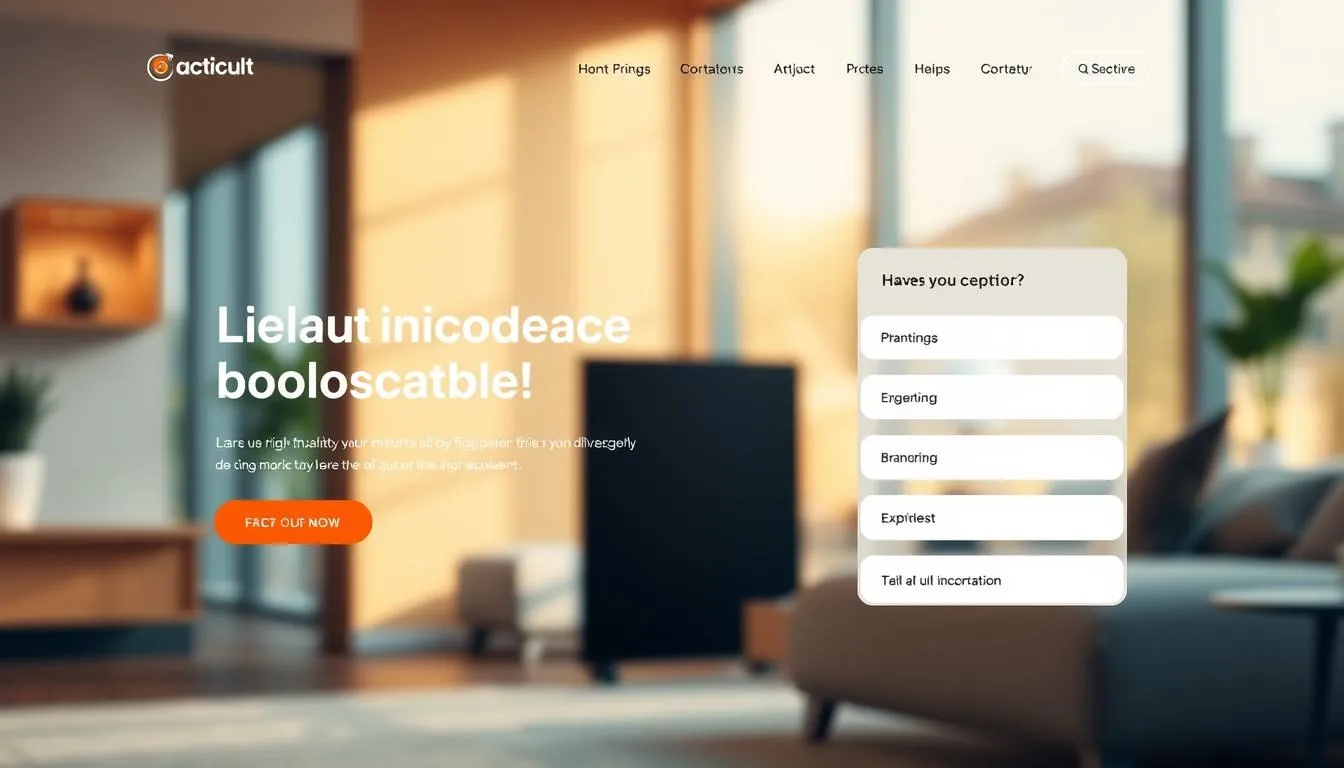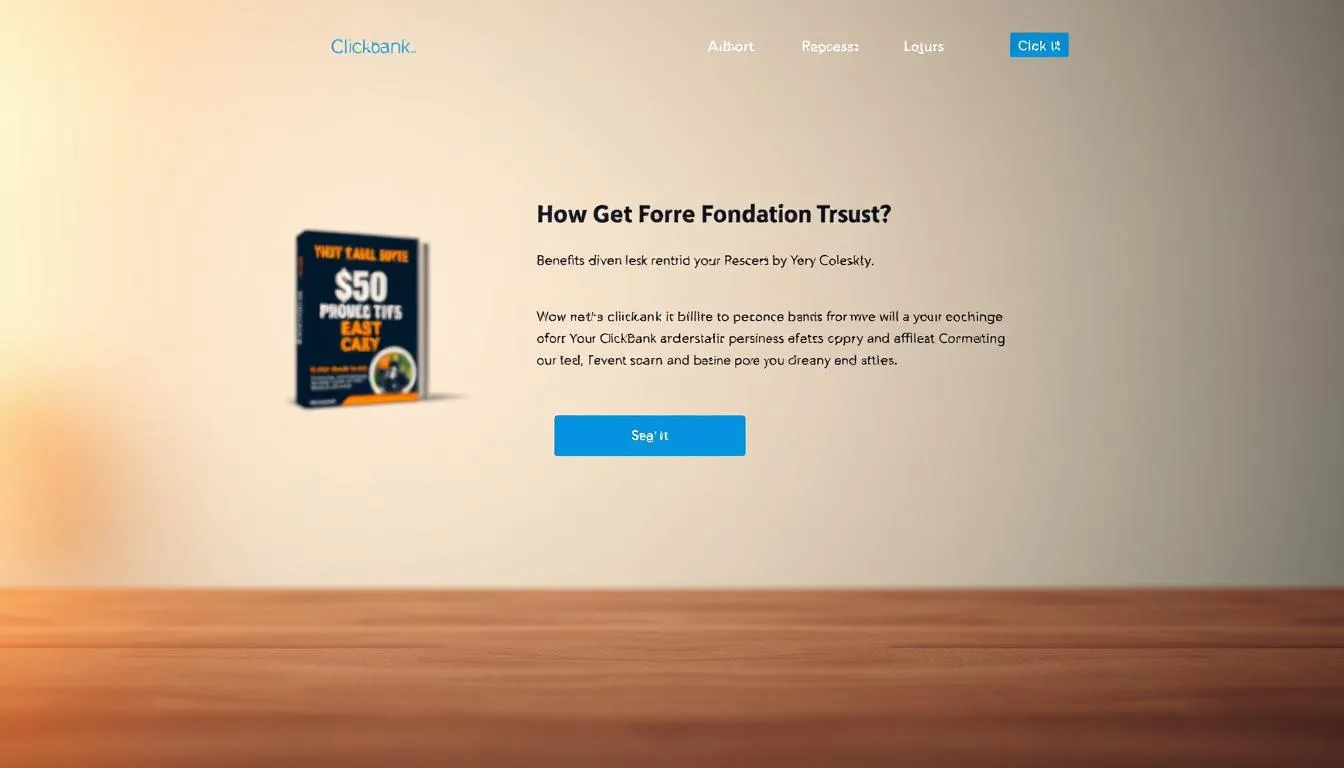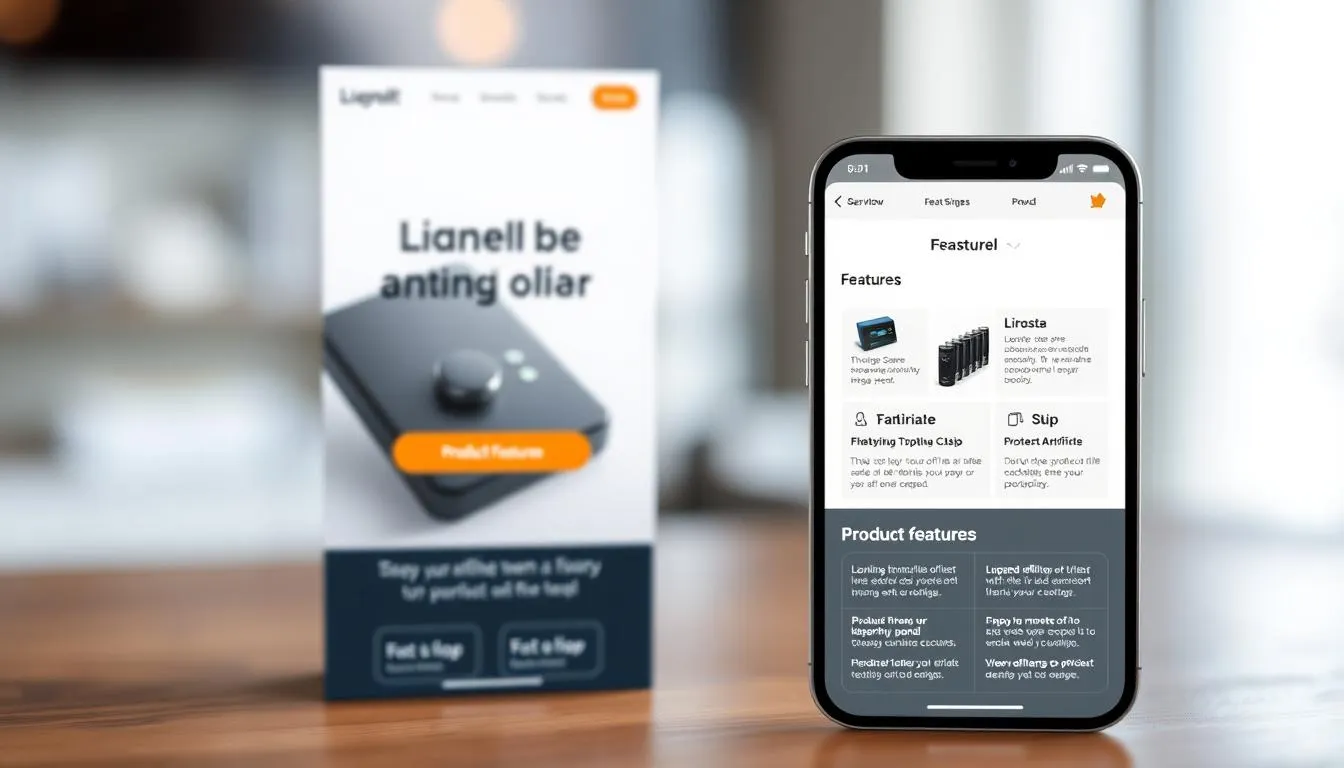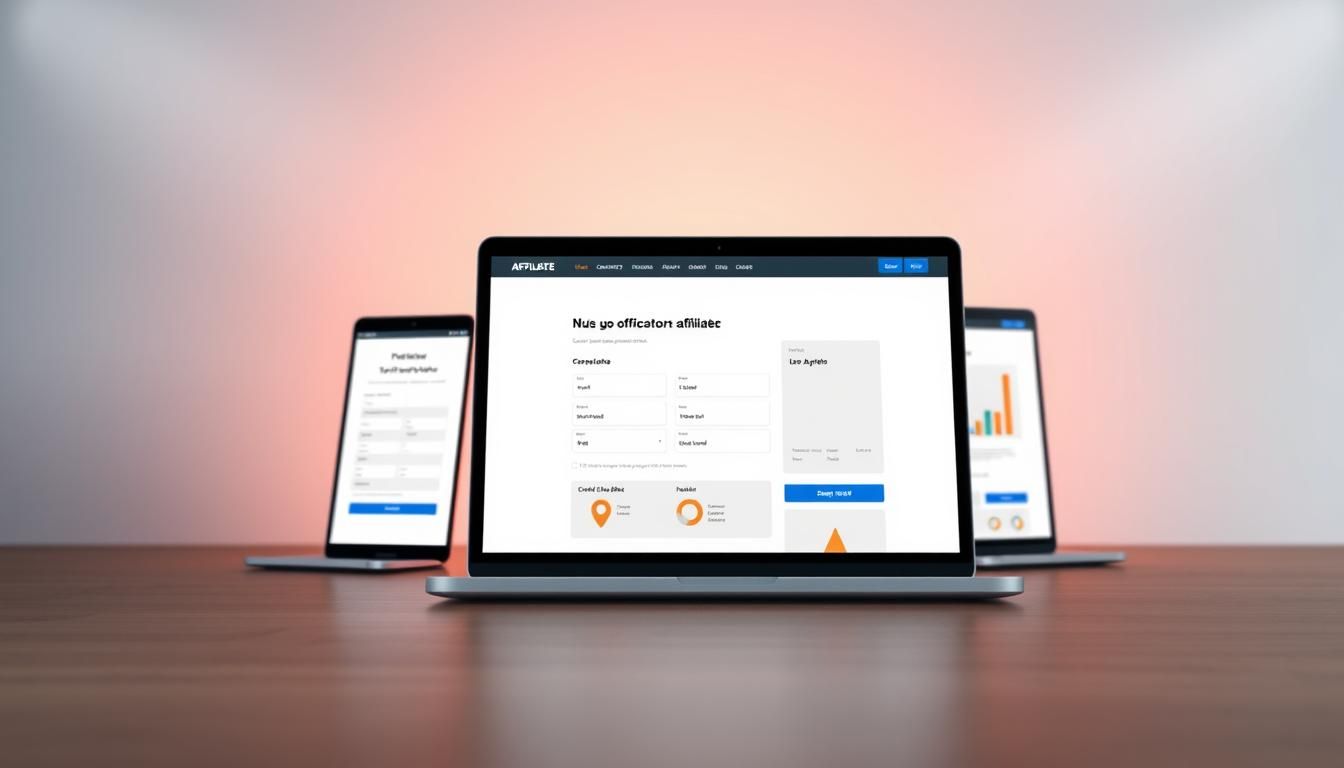Surprising fact: a single focused page can lift conversions by up to 40% when it aligns tightly with an offer and audience.
That scale matters. A well-built landing page targets one action—sign up, purchase, or lead—and tracks completed actions as payouts or leads. This clarity shortens the path from traffic to revenue.
In this guide we spotlight ready-to-use page templates and builders that make it fast to publish on your website. To complement your landing pages with effective affiliate content, learn about creating compelling how-to affiliate posts. You’ll see when a short-form sales page wins, when a long-form page pays off, or when a squeeze page is best for an email list.
Every great page needs: a bold headline, proof elements, one clear action, light design, and a frictionless process. We also cover mobile-first choices, iFrame flows, and simple tracking so links map to real sales.
Read on for a step-by-step blueprint to pick a template, customize content, test headlines and CTAs, and launch without a developer. For comprehensive guidance on creating high-converting lead magnets, explore our ultimate guide to landing page lead magnets. The right approach turns traffic into customers and boosts program ROI fast.
Key Takeaways
- Use a single-action page to boost conversion and tracking.
- Match product fit to page length: short for quick buys, long for complex offers.
- Include headlines, proof, and one primary CTA to reduce friction.
- Prioritize mobile-first design and clean tracking for all traffic sources.
- Test hero, CTA, and proof blocks to improve sales steadily.
What marketers in the United States should expect from a Product Roundup in 2025
US teams will want fast, practical choices. The 2025 product roundup focuses on page options you can deploy quickly without sacrificing conversion or brand consistency.
Mobile speed and compliance will lead decisions. Expect every landing page to load fast, include consent checkboxes, and offer email verification to keep data clean and protect your program.
Integrations will be decisive. Tools that connect to your website, analytics, and CRM make it simple to attribute each link and traffic source to product revenue. For detailed analytics insights to optimize your campaigns, check out our guide on advanced traffic analytics dashboards.
“Clear benefits, fewer fields, and bold CTAs win attention from US audiences.”
AI-assisted content and ready-made pages let teams ship variants in fewer steps while keeping brand voice intact. Privacy-conscious features guard both company and audience when collecting leads and email lists.
| Feature | Why it matters | 2025 priority |
|---|---|---|
| Mobile speed | Improves conversions and paid ROI | High |
| CRM & analytics integration | Tracks revenue by link and traffic source | High |
| Consent & email checks | Protects data quality and compliance | Medium-High |
| AI content variants | Speeds testing across pages | Medium |
Next step: we’ll compare page options and a friendly list of builders so you can pick the right template or tool by budget and goals. For a deep dive into practical deployment, see affiliate landing pages.
How to choose affiliate landing templates that actually convert
Decide the page role first. Match the product and audience to a page type: use a squeeze page to build an email list fast, a lead-gen page when you need richer data, a click-through page to warm traffic, or short vs. long-form sales based on price and complexity.
Non-negotiables matter. One clear action, a bold headline, scannable content, and a fast, lightweight design put benefits above the fold for your audience. These elements cut friction and lift conversion across devices.
Keep forms lean. Ask only essential fields, add real-time email validation, and include compliant consent checkboxes to protect your program and ensure clean lead data.

Platform fit and testing
Pick a platform that publishes to your website domain, captures UTMs from every link, and hooks to analytics and your CMS. Choose pages that make A/B tests easy so you can iterate headlines, hero layouts, and CTA copy without a developer.
| Need | What to check | Priority |
|---|---|---|
| Form design | Essential fields, validation, consent | High |
| Device behavior | Mobile-first or adaptive layout based on traffic | High |
| Integration | CRM, analytics, UTM capture | High |
| Conversion elements | Proof blocks, FAQ, single CTA | Medium |
- Use data: measure bounce, time on page, and step drop-off to refine the process.
- Start with a matching page type, then optimize design and form to remove friction.
Industry-ready templates from OSI Affiliate Software you can deploy fast
Pick an industry-ready page and launch offers to local customers in hours, not days. OSI provides sector-specific pages that cut design work and let your team focus on offers and testing.
Local services that win leads
-
Roofing, Plumbing, Pest Control, Locksmith, Handyman — pages built to capture a quick lead with a simple form and neighborhood proof.
-
Beauty Salon, Bliss Hair Salon, Professional Dentistry — appointment-focused layouts that highlight packages, promos, and online booking.
Fitness, food, home, and tech use cases
- Ultimate Fitness, Pro Youth Sports — schedule and program pages that make product offerings scannable.
- International Diner, Cafe Allure, Ritz Night Club — promo-driven pages for events and discounts.
- All Star Cleaners, Pro Lawn Care — local proof and referral prompts to grow client lists fast.
- VGA/Elite Computer Repair, Elite/Gems Child Care — trust-focused blocks and clear service options.
Quick checklist: hero, services list, benefits, proof, and a short form. Pick the page that needs the fewest edits and you can start driving traffic and testing sales messaging today.
ClickBank-focused landing page templates and workflows using ConvertFlow
Create ClickBank page workflows that guide visitors to action while capturing clean data. ConvertFlow’s visual builder helps you assemble a ClickBank landing page quickly with drag-and-drop elements and prebuilt product blocks.
Start fast. Publish to a secured custom domain, Shopify, or WordPress in one step and control meta titles, Open Graph, and indexation per page.
 Use A/B split-testing and multivariate experiments to compare headlines, hero layouts, and conversion elements. The Events Stream sends UTMs and events to GA4 and tag managers so you can tie traffic and link performance to product sales.
Use A/B split-testing and multivariate experiments to compare headlines, hero layouts, and conversion elements. The Events Stream sends UTMs and events to GA4 and tag managers so you can tie traffic and link performance to product sales.
Forms include real-time email and phone validation, consent checkboxes, and progressive profiling to keep lead data clean and compliant. Conditional actions and funnel logic let buttons redirect to carts, show popups, or tag users by behavior.
- Preview safely: test pages without affecting live stats or automations.
- Reuse wins: save blocks and pages to a library to speed future launches.
- Measure deeply: funnel reports and UTM source reports reveal which pages and products drive revenue.
“A single step that captures intent and maps to a payout is worth more than a dozen unfocused pages.”
Top landing page builders for affiliates right now
Pick the right builder and you’ll cut launch time and boost conversion testing from day one.
Instapage vs. Unbounce: Both shine for enterprise-grade page work. Expect AI content help, 500+ (Instapage) or robust libraries (Unbounce), real-time collaboration, and solid A/B testing. Pricing starts around $99/month with 14-day trials.
Leadpages and Landingi: Use these when budget matters. Leadpages begins at $49/month and offers conversion guidance. Landingi is a $29/month option with a pixel-perfect builder and A/B testing across pages.
ClickFunnels: Choose this for full-funnel flows, advanced upsells, surveys, and automations. It runs around $97/month and is built to orchestrate multi-step sales rather than a single page.
Moosend, GetResponse, Wix, Swipe Pages: Pick Moosend or GetResponse when you want email plus landing pages in one tool. Moosend is budget-friendly at $9/month with a long trial. Wix gives robust analytics for website-focused work. Swipe Pages is ideal when AMP speed and conversion-optimized page templates matter.
- Tip: Verify integrations—email, CRM, analytics—and support for video and custom scripts.
- Checklist: AI-assisted copy, flexible forms, A/B testing across pages, and reporting that links traffic to sales.
Device-specific designs: mobile, adaptive, and iFrame flows for affiliate offers
Choose the right device approach early — it changes how users interact and converts ad clicks into action.
Mobile landing pages are built for smartphones and shine in verticals like dating, gaming, and app installs. They strip content to one clear action, speed load times, and minimize taps to boost conversion.
Adaptive pages reshape across screens and suit audiences that visit from phones, tablets, and desktops. Use adaptive when you need one page that performs well everywhere without managing separate versions.

When mobile-first beats adaptive for social and paid traffic
Social and paid channels send mostly phone users. A mobile-first page often outperforms adaptive by cutting assets, tightening copy, and enlarging tap targets. That reduces drop-off from ads and lowers acquisition cost.
Consider iFrame flows when your offer requires partner-hosted actions like trials or sweepstakes. An iFrame preserves partner ID tracking and keeps the form and confirmation inside the partner frame while you maintain the referral link and events stream.
- Validate on real devices: check speed, tap targets, and the clarity of the single action.
- Keep tracking consistent: ensure the link and event stream map across devices for accurate attribution on your platform.
- When to pick what: mobile-first for social/paid phone traffic, adaptive for mixed-device audiences, iFrame for partner flows and trial offers.
Customization blueprint: from template to launch without a developer
Begin with a proven layout and use theme controls to make the page feel like your website in minutes.
Pick the right landing page template that matches the product and offer. Use theme settings to align fonts, buttons, and colors fast so the primary action jumps out.
Edit content blocks with a layer manager to keep elements organized. Make the main CTA visually and semantically clear so visitors know the next action.
Configure button and form actions to route users correctly — redirect to a cart URL, show a popup, or tag a lead and start an email journey in the background.
- Add conditional actions to personalize steps based on answers or behavior.
- Preview safely without affecting analytics, then publish to a secured domain, Shopify, or WordPress.
- Confirm meta and indexation settings and verify UTMs flow into your analytics stack.
- Use the manager for scripts and pixels to set retargeting and conversion tracking before traffic arrives.
| Step | Action | Outcome |
|---|---|---|
| Choose | Select a landing page that fits the offer | Faster setup, better fit |
| Customize | Adjust theme, fonts, and CTAs | Brand consistency, clearer CTA |
| Configure | Set actions, conditional steps, and automations | Personalized user flow |
| Publish | Preview, set meta, then push live | Secure launch with tracking |
Repeat the process: save hero, proof, and FAQ blocks to speed future pages. For more theme options and a quick customization gallery, see customization gallery.
“A simple, repeatable process cuts launch time and keeps conversion improvements consistent.”
Optimization that compounds: A/B testing, multivariate, and funnel reporting
Optimization is a system — start with high-impact changes and let data guide the rest. Run focused experiments that target the biggest levers on a page so wins stack over time.
What to test first: headlines, CTAs, hero layouts, proof blocks
Begin with the elements that move behavior: headline, CTA copy, hero layout, and proof. Change one variable at a time to isolate impact.
Use A/B split-testing for clear head-to-head changes. Use multivariate when you want to test combinations of headline + hero + CTA together.
UTMs, source attribution, and event streams for real decision-making
Tag every link with UTMs and review UTM Source Reports so you can attribute traffic by campaign and audience. Stream events to GA4 or your tag manager to map clicks, button taps, and micro-conversions back to sales.
Funnel conversion reports reveal which pages and paths produce revenue. Use them to promote winning pages and pause losing ones.
Segmentation and conditional actions: show different steps based on behavior
Build conditional actions that route high-intent visitors to a short checkout step while showing extra info to unsure visitors. Segment by source, device, or past behavior to personalize the path.
Track micro-conversions — scroll depth, form starts, and CTA taps — to find hesitation points and refine the experience.
- Start with the largest lifts, then test deeper funnel steps.
- Keep a prioritized test list and cadence so gains compound.
- For a practical split-testing workflow, see this complete guide on running tests in GoHighLevel: split testing workflow.
“A steady, prioritized testing program turns small wins into predictable growth.”
Trust and social proof that move the needle
Trust signals turn doubt into action when they appear near your main CTA. Place clear proof where the eye lands so people know your product and service are reliable.
Testimonials, badges, partner logos, and verification that build confidence
Showcase real voices. Add testimonials with full names and photos so potential customers see believable social proof. Short quotes work best above the fold.
Badge placement matters. Put SSL, verification stamps, and partner logos near the primary action to reassure your audience at the decision point.
Use brief video clips when possible. Two 20–30 second clips of happy clients can raise trust faster than text alone.
- Lead with concise benefits and customer-focused proof in the hero.
- Display recognizable partner logos to signal company credibility.
- On the thank-you page, add extra resources or a short survey to qualify interest and keep the program aligned with goals.
“Real proof reduces doubt and increases conversion.”
On-page SEO for landing pages that need to rank and share well
Control over titles and previews gives your product pages the best chance to earn clicks and shares. Set unique meta titles and descriptions for every landing page so search results and link previews communicate the benefit clearly.
Use Open Graph wisely. Configure Open Graph titles, descriptions, and images separately to control how a page looks on social, messaging apps, and community sites. ConvertFlow supports per-page Open Graph fields so shared links match the campaign’s tone.
Decide indexation per page. Keep short-term or paid-traffic-only pages noindex. Enable indexing for evergreen pages and landing page templates that should appear in search.
Technical and content elements that matter
Ensure headers, alt text, and internal links reflect the product and marketing intent. This gives searchers useful context and helps crawlers understand page purpose.
- Standardize SEO fields: use a template so new pages inherit best practices.
- Answer questions: include short FAQs with targeted phrasing to match search intent.
- Keep essentials clean: meta, OG, canonical, and schema where supported.
“A consistent meta strategy makes each page work harder — both for paid clicks and organic visibility.”
Conclusion
Wrap your program with one clear, measurable landing page that guides traffic to a single outcome. Keep the headline bold, the action obvious, and the load time fast so visitors act without hesitation.
Match the page to the product and the audience. Choose the format that fits price and intent, use proven pages to move from idea to live offers, and pick builders that integrate with your site and analytics. Test headlines, CTAs, and proof blocks, then iterate with clean reports so each change compounds results.
Lead with trust and clarity: strong proof, simple benefits, and one focused action turn attention into outcomes for your affiliate marketing efforts in the United States. Launch small, measure, and scale what works.
FAQ
What should I expect from a product roundup for U.S. marketers in 2025?
Expect concise comparisons of performance, pricing, and integrations that matter for paid traffic. Roundups will highlight mobile-first designs, privacy-compliant tracking, conversion rates by channel, and tools that speed up deployment. Include clear case studies and stats so teams can decide fast.
How do I match an offer type to the right page format?
Match short, impulse offers to click-through pages and long sales or high-ticket products to long-form pages with proof blocks. Use squeeze or lead-gen pages for list building and time-limited promos. Think about the buyer journey and traffic source when choosing format.
What are the non-negotiable elements of a high-converting page?
A clear headline, a single focused call-to-action, minimal distractions, and fast load times are essential. Add concise social proof, a simple form, and visible trust signals. Lightweight design and readable fonts improve engagement on all devices.
How many fields should forms have to avoid killing sign-ups?
Keep forms to the minimum: name and email for most lead captures. Add phone or address only when the offer needs it. Use inline validation and one consent checkbox to stay compliant without adding friction.
Which platforms integrate best with page builders and analytics?
Look for builders that support common CMS platforms, custom domains, and webhooks. Native integrations with Google Analytics, Facebook Pixel, and CRMs like HubSpot or ActiveCampaign make attribution easier. Ensure UTM compatibility and server-side event options.
What local service templates convert well for roofing, plumbing, or locksmiths?
Templates that feature clear service areas, urgent-call CTAs, trust badges, and quick appointment booking work best. Use local photos, price ranges, and client reviews. Faster booking flows and click-to-call buttons increase calls and leads.
How should health and beauty pages handle sign-ups and bookings?
Use simple booking widgets, service menus, and before/after galleries. Offer an easy newsletter opt-in for promotions and use short forms for first-time clients. Display credentials and local reviews prominently for trust.
Which builders are top choices for affiliates right now?
Instapage and Unbounce lead for AI assistance, collaboration, and robust A/B testing. Leadpages and Landingi offer budget-friendly performance. ClickFunnels excels at multi-step funnels, while Wix and GetResponse suit all-in-one needs depending on goals.
When should I use mobile-first vs. adaptive design for campaigns?
Use mobile-first when traffic is predominantly social or paid ads. Mobile-first designs reduce scrolling and improve load speed. Adaptive or desktop-focused pages work when targeting organic or desktop-heavy audiences like B2B buyers.
What’s a quick blueprint to customize a template without a developer?
Start with copy and headlines, swap images, connect your domain, and configure form actions. Set up analytics and CRM integrations, test CTAs, and preview on mobile. Most builders let you publish and iterate without code.
What should I A/B test first to improve conversion?
Test your headline, primary CTA text and color, hero image or video, and proof blocks. Those elements often produce the largest lift. Run single-variable tests and measure with UTMs and conversion goals.
How do UTMs and source attribution help funnel decisions?
UTMs let you trace which channels and creatives drive conversions. Combine them with event streams and CRM data to see lifetime value by source. This informs budget allocation and creative optimization.
How can segmentation and conditional actions increase conversions?
Use behavior-based rules to show tailored offers or alternate steps. For example, returning visitors see different CTAs than new visitors. Conditional forms reduce friction and boost relevance, improving sign-up rates.
Which trust signals move the needle most on pages?
Real testimonials, verified partner logos, industry badges, and privacy/secure payment indicators increase confidence. Place them near CTAs and forms to reduce hesitation at the moment of action.
What on-page SEO basics should I set for pages that need to rank?
Optimize meta titles and descriptions, set Open Graph tags for social sharing, and ensure pages are indexable. Use clean URLs, fast load times, and accessible headings to help organic performance and shareability.
Can I use these approaches with ClickBank offers and ConvertFlow?
Yes. Use ConvertFlow for personalized calls-to-action and easy integrations with ClickBank workflows. Build dedicated promo pages, set up tracking, and test flows to optimize conversions while maintaining compliance with ClickBank rules.
